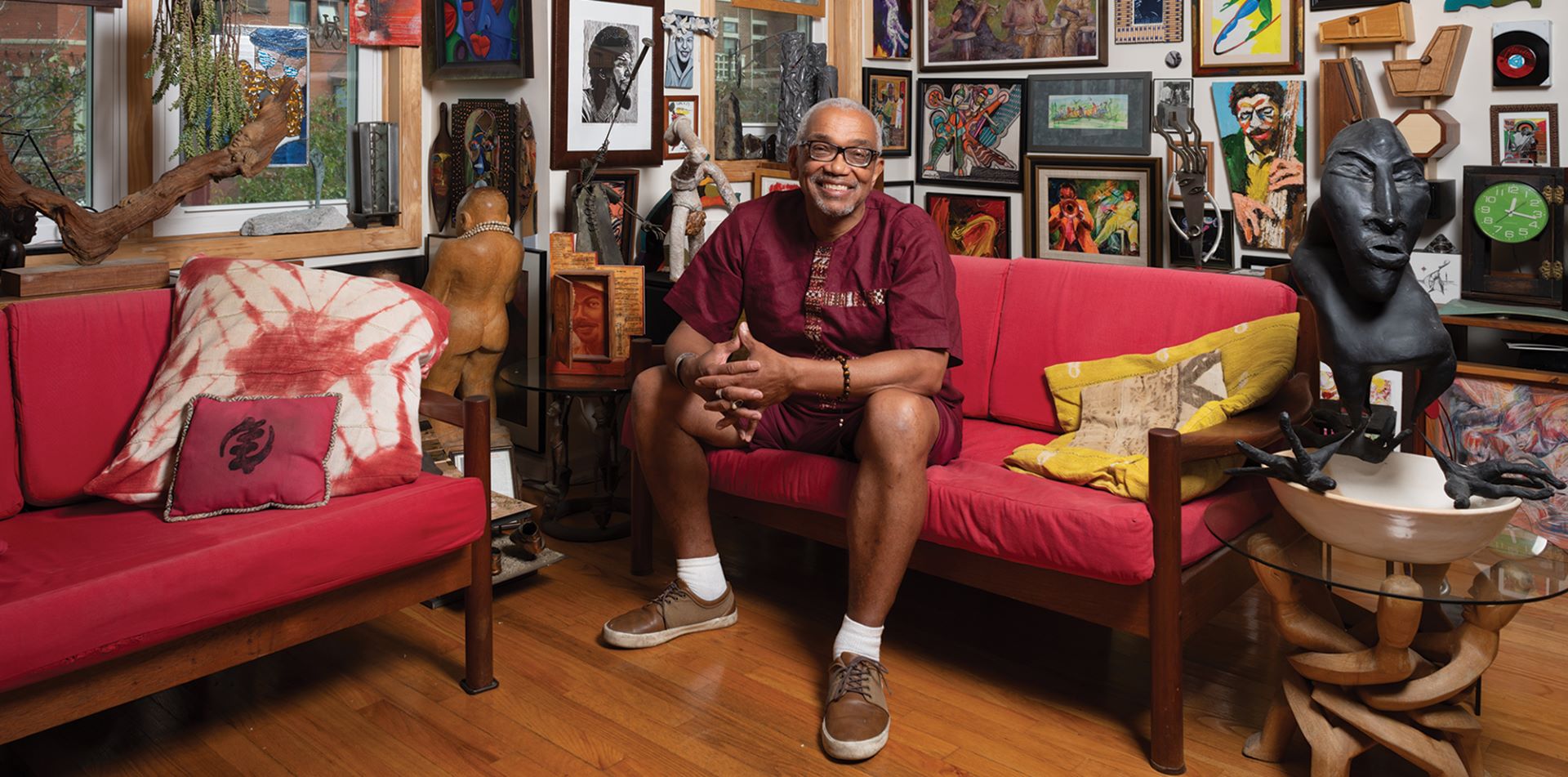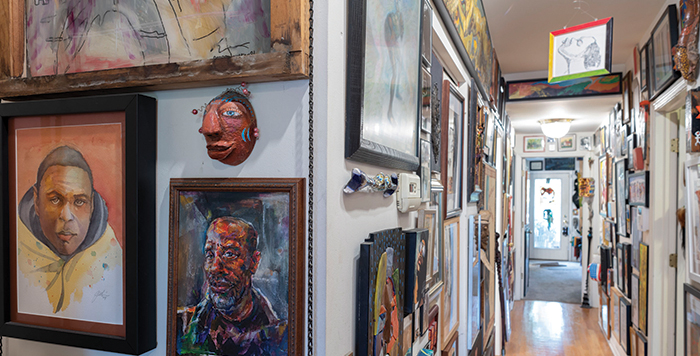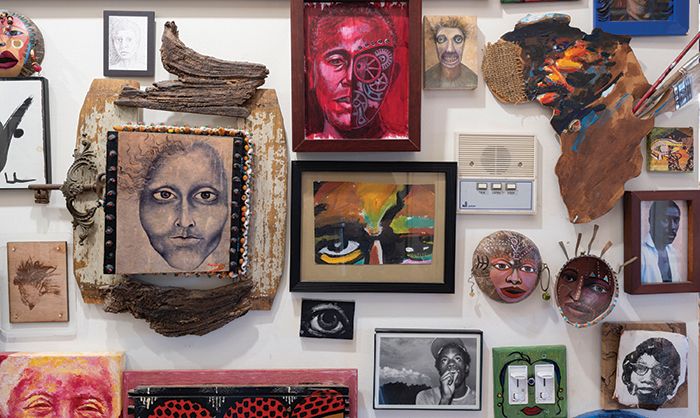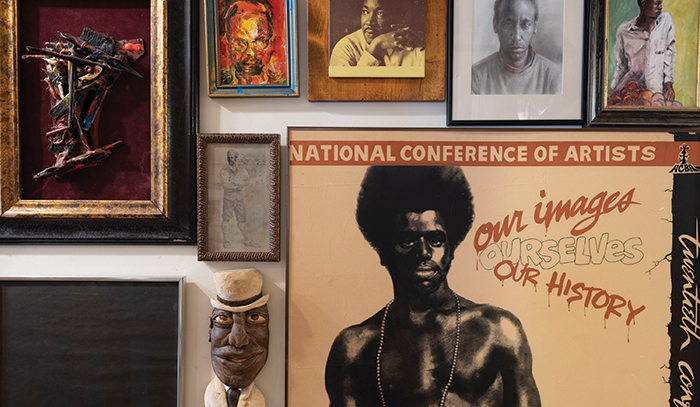
Patric McCoy in his living room. The works throughout his apartment are arranged by theme; this is the music/dance section. (Photography by Nathan Keay)
Over 50 years, Patric McCoy, AB’69, has collected 1,300 pieces of art and made them into a piece all his own.
Patric McCoy, AB’69, a retired environmental scientist, bought his first piece of art when he was an undergrad. In 1968 his roommate Scott Stapleton, BFA’68, came back from art class with a lithograph he called “The Seventh Angel of Revelation.”
McCoy was fascinated. “It had an ominous look to it,” he says. “Back in the ’60s we were really thinking these were the last days.” They negotiated over a price and settled on $10 (about $72 today). “It tickles me now to think about it. That really was a lot of money.”
McCoy estimates he has about 1,300 works—mostly, but not exclusively, by contemporary artists from the African diaspora—in his three-bedroom North Kenwood apartment. Among them is work by Theaster Gates and the AfriCOBRA collective; he also still displays Stapleton’s lithograph. In 2003 McCoy cofounded Diasporal Rhythms, an organization that encourages art collecting.
This interview has been edited and condensed.
In an article about your collection, the New York Times described you as a “fully committed zealot.” Is that accurate?
Yes, 100 percent. When I was in the EPA, I was in it to win it. When I was teaching, I was doing that. The concept of promoting art collecting is something I feel very, very strongly about.
We as a society are suffering because we keep perpetuating these myths about what a collector is—elitist, unusual, super wealthy, crazy in their concern about privacy and security, academic beyond belief, and possessed with an interest in investment. That’s not real. That’s not healthy.
How long were you buying art before you called yourself a collector?
About 30 years. That’s why I know these myths and misconceptions are real. I had them myself.

The article also claimed you wouldn’t allow the pieces by Theaster Gates to be photographed.
I’ve got a lot of Theaster Gates because I’ve known him for a long time. They got excited and wanted me to take his work and set it out in a different arrangement so they could photograph it.
This is curated. This is mine. You’re asking me to change my collection, just for a photograph? I’m not doing that.
Was Gates famous when you started buying his work?
No, no. In fact he said I was the first person that bought anything from him.
I bought some pieces in 2000, right after I met him. I went over to the West Side, he showed me some pieces, and I bought three right then. Clay masks.
One broke 10 years ago—it fell off the wall. I put one in an auction for Diasporal Rhythms this past Sunday. And one I really like, so I keep it in my living room. I enjoy it.
Your focus is on art that’s contemporary to you.
That’s correct. You cannot affect a dead artist’s career. When I engage with the artists, through my acquisition or going to their shows, I’m encouraging them to keep doing it. How many blues, jazz, gospel, R&B, rap artists would continue to do what they do if they had no audience? This is what we’re doing with our visual arts.
I go to a lot of shows, and a lot of times I don’t like most of it. I take the time to talk to the artist about why I don’t like it.
How does that go over?
Ninety percent of the time they love it. One of the things I critique immediately are these artist’s statements on the wall. I tell them, I went to the University of Chicago, and we had to read some very complex things. So I’m comfortable with complex thought, but I can’t make sense of what you’re saying. When I try to diagram that, that’s not even a sentence.

Did you ever have to eat ramen because you spent all your money on art?
Not eat ramen, but I have spent all my money. It’s lucky I was working for the EPA and was so aggressive and committed. I rose up in the ranks to the point where I was getting paid very well. During that period I was able to buy a lot of work.
Most people don’t recognize that Chicago is one of the cheapest art markets for African American art. It is more expensive in the South, East, and West. I don’t know if it’s a well-kept secret or people are just ignorant.
You’re originally from Chicago?
I was born at 63rd and Champlain in a little two-room apartment right next to the L. I was the valedictorian from Englewood High School.
During Orientation, the University of Chicago representative said the area was dangerous. They recommended that you not go past 61st Street, not go across Cottage Grove. I’m thinking, you’re telling me I can’t go back home? Now I see students walking across Washington Park like they own it.
So when you come home with a new piece, now what?
I shuffle things around. One of the things I learned at U of C—there’s a math field called topology. You can have a particular orientation of things and it looks like it’s full, and all of a sudden, boom: you’ve got all this space.
I like the smaller pieces. I find that there is the same if not more work done in a small piece than in a big piece. You’re really seeing the expertise of the artist in a small piece.
Do you ever have buyer’s remorse?
There’s always going to be something that you rethink. It’s not so much that you have buyer’s remorse. It’s that you grow out of it.

You have some artwork on the floor. And you’re starting in on the ceiling.
I have already freed myself from a lot of the constrictions of the American art world—that it’s got to have so much breathing room and this color shouldn’t go with that. I’m past that.
When you look at your walls, does your gaze go to certain things over and over again? Or do you look at different things?
Different things. Sometimes you start seeing relationships that you hadn’t paid any attention to before. It depends on the time of day, different lighting, how you feel. It changes.
Any advice for aspiring collectors?
Get what you like. You see something you like, get it. Ask if it’s for sale and what the price is. If you can do that price, you should get it. It’s as simple as that.
You start out with stuff that you might grow out of: I thought this was great, but now it’s not. If you’re in the Chicago market, where it’s not that expensive, then it’s not a problem. Get something else.
If you see something you like and you will regret not getting it, then you really do need to get it. If it speaks to you, you need to get that. Those pieces—I’ve been collecting now for 50-some years—that I have seen and I did not get, I still remember them.
